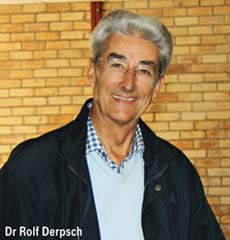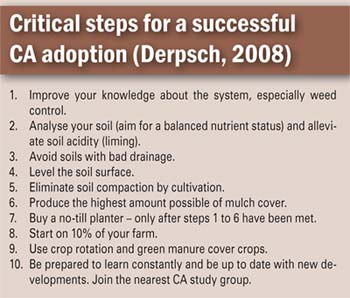February 2014
DR HENDRIK SMITH, Conservation Agriculture Facilitator, Grain SA
 For two days in August last year, Grain SA’s Conservation Agriculture (CA) programme entertained a number of participants through two awareness events with Dr Rolf Derpsch as presenter. On the 14th the event was held in Pretoria for Limpopo, Mpumalanga and Gauteng and on the 15th at NAMPO Park in Bothaville for the Free State and North West Province.
For two days in August last year, Grain SA’s Conservation Agriculture (CA) programme entertained a number of participants through two awareness events with Dr Rolf Derpsch as presenter. On the 14th the event was held in Pretoria for Limpopo, Mpumalanga and Gauteng and on the 15th at NAMPO Park in Bothaville for the Free State and North West Province.
The information and lessons learned during these events are seen as critical to improve practices of existing CA producers, but also to spark the interest and knowledge of producers interested to start CA. In more detail the dialogue with Dr Derpsch during the second event is highlighted below.
Q: Is it necessary to till (rip) the soil under CA at some stage?
A: Any disturbance of the soil after you have started CA will bring you back to the start and you will not reap the full benefit of the system. If you apply the three principles of CA correctly, there will be no need to rip the soil at any stage. When crops such as peanuts are used in CA, the soil will be disturbed when these crops are harvested. A partial solution to this problem is to cover the soil, preferably with cover crops, as quickly as possible after harvest.
Q: How should we treat very sandy soils (less than 5% clay) with very low soil organic matter in dry areas under CA?
A: These types of soils are also found in other areas, for example in Paraguay, which has been degraded by tillage and have soil organic matter levels of around 0,2%. This is the worst situation to start CA that you can think of. However, even in these situations CA is the better solution to recuperate degraded soils and farm sustainably (see Photo 1).
In these severely degraded sandy soils probably the best alternative is to establish a long term grass ley cropping system for around five years using African grasses for example. Otherwise annual cover crops with a high below- and above-ground biomass, such as Sunhemp (Crotalaria juncea) or Pearl millet/Babala (Pennisetum glaucum) should be incorporated into the cropping rotation.
You will have to invest something to improve the condition, which is ultimately leading to higher soil organic matter. So you will have to find out which are the crops that will give you the best results in these conditions, i.e. the highest amount of biomass in the shortest possible period.
Q: Do you think we will run into disease problems under CA, especially soil-borne diseases?
A: Entomologists and pathologist are always concerned about this issue, warning that it will cause a collapse of the whole cropping system. Fortunately nature is a little bit wiser than us, because predators or other beneficial organisms, which could not survive under conventional tillage, will also increase under improved conditions (under CA).
Under higher soil organic matter and crop diversity levels, the soil is much more resilient. Aphids, for example, do not like residues. Some pests will decrease, others will increase, but eventually you will have a balance.
Q: Isn’t root density more important than soil cover?
A: It is certainly an under-emphasised factor. It is always a good idea to increase the diversity, amount and quality of (living) roots in the soil, such as using African grasses.
Q: How should we manage residues for better wind erosion control on the sandy soils?
A: Of course, the more residues you leave on the soil surface, the better (see Photo 2). The higher the maize stalks are cut above the soil surface, the better for avoiding wind erosion. Standing stubble is more efficient than laying stubble for wind erosion control. Planter technology has improved drastically in order to plant in these conditions.
A knife-roller (roller-crimper) could also be used to flatten cover crops, but the design and use of it should be correct, i.e. the blades should be blunt and it should not be too heavy or too light. In a region with yields of 7 ton/ha and a similar amount of crop residues, there should not be any problem with erosion, provided that all the residues are left on the soil surface.
 Q: What about the use of different cultivars under CA?
Q: What about the use of different cultivars under CA?
A: Very little work has been done to develop cultivars specifically for CA, but it is an issue to keep in mind and research should be encouraged on it.
Q: What is your experience with row-width and plant population, e.g. using 0,5 m row width and higher plant populations, such as in Argentina?
A: I would be cautious because plant population depends on rainfall. You could increase the plant population a little bit. If your situation allows higher plant populations with narrow rows, weed control will be much easier, since your canopy cover will suppress weed growth.
(Comment from Wynn Dedwith from Parys, Free State: Have done trials with 16 000, 20 000, 24 000 and 40 000 plant populations under 0,9 m and 0,5 m row width; under high populations the 0,5 m row width was doing better, apparently because of better micro climatological conditions in the maize field. Varieties with single cobs and no suckers seem to do better.)
Q: In sandy soil areas with low rainfall (around 450 mm per annum) and high temperatures, soybean rotated with maize leaves very little residues. How can we improve this situation?
A: In similar conditions in Brazil they have developed a crop rotation system where they are seeding winter cover crops (such as black oats or Brachiaria) by air before harvesting maize or soybean, to utilise the residual soil water and nutrients and leave a thick, living mulch right into the next planting season. There are other options to enrich the crop rotation, since there are thousands of potential plant species to consider. Crop diversity is the key and cover crop mixtures could be a real solution.
Q: What is the best way to integrate livestock?
A: If you want to improve the soil organic matter as quickly as possible, it is better to keep animals out of the cropping fields completely by separating the grazing system (e.g. under a long-term grass ley crop) from the cropping system. This will stop the removal of crop residues by animals. These two systems can be rotated after a number of years, e.g. after five years. The ley crop will also help to recuperate the (degraded) soil, preparing it for more productive cropping.
(Comment from Wynn Dedwith from Parys, Free State: By taking better care of pastures for livestock, it is possible to keep animals out of crop fields and retain residues.)
Q: Some producers in South Africa incorporate cover crops into the soil using tillage. What is your view?
A: Incorporating cover crops using tillage implements is something from the old, old books. In the olden days there was no other way of seeding a crop than previously incorporating the cover crop with tillage. From our experience in South America, we ask the question: Why should we incorporate cover crops? On the soil surface the crops will mineralise slowly (i.e. slow release of nutrients), compared to quick mineralisation with tillage. My recommendation would be to leave the cover crops on the soil surface, since it will be incorporated by nature through a biological process (see Photo 3).
Q: We have the experience that no-till disc planters do not penetrate into clay soils. When are tine or disc planters appropriate?
A: This discussion has been going on in South America for many years. Herbert Bartz (pioneer CA producer in Brazil) has been doing CA with discs under high clay soils very successfully.
My opinion is that tine planters would be appropriate during a transitional phase, where you are starting CA with soil organic matter levels of 0,2%, for example. But if you want to go to the top of the system and quickly accumulate soil organic matter you must switch to discs. When you are using tines, especially in narrow row spacing, you are actually ‘tilling’ the soil.
(Comment from Cobus van Coller from Viljoenskroon, Free State: We usually have compaction in the first 10 cm - 15 cm in degraded sandy soils; we use a small tine (12 mm - 13 mm wide) on the no-till planter, which we believe will probably work better for the first seven to ten years while we have the compaction, whereafter a disc planter could be introduced.)
Q: How do you apply fertilisers under CA?
A: There are different schools of thought. Some say you can fertilise in the row for a period, whereafter you can broadcast and your crops will respond well. Others say you don’t have to fertilise soybeans, since it responds very well to residual fertiliser of the previous crop, usually maize.
So, if you have large areas of land to plant, your operation will be much quicker if you don’t have to fertilise, i.e. if you don’t fertilise soybean and apply all your fertiliser to the maize. Another system that is used is to heavily fertilise the cover crop, flattening it down and these residues and roots will return (recycle) the soil nutrients making them available to the next crop (see Photo 4).
Q: Why do you want to flatten the cover crops mechanically?
A: First of all, we would like to keep the chemical use as low as possible. I would like to remind you that glyphosate is not so benign, since it causes problems in the long run and I am concerned that we are relying too much on only one herbicide. So whenever we have the opportunity to avoid glyphosate, I would prefer to use this alternative.
I am not against glyphosate; if it disappears from the market, CA will have a huge problem. However, we have to diversify our herbicide programme and when you rotate crops you are forced to rotate herbicides. If you are doing monoculture with GM crops, you are constantly increasing your dependence on glyphosate (see Photo 5).
Q: Is it better to control weeds within a matured maize stand (and use glyphosate again)?
A: I would prefer to use a inter row spraying (e.g. with gramoxone and 180° nozzles at the latest stage you can drive in with your tractor) to avoid harvesting with weeds and the reseeding of weeds. If the weeds produce seeds, they cannot serve as a “cover crop”; if they do not produce seeds they can, but biomass production from weeds is generally quite low.
The presentations and dialogue with Dr Derpsch clearly illustrated the range of benefits resulting from CA, pressing the urgent need for producers to adopt the system, especially in South African conditions that are prone to soil degradation and droughts.
Responses from participants who attended these two events were very positive, sparking new momentum to the much needed thrust to promote CA among grain producers in South Africa.
Publication: February 2014
Section: Input Overview